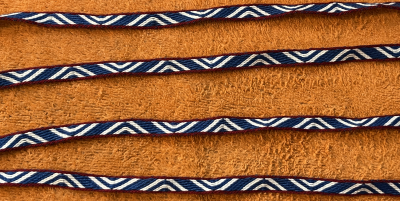'Tis done.
I really like it!
After my last post, I thought about things for a while. I looked at the photo in the book, and decided that I wanted the band to be symmetric. So I eliminated the rows that required me to push down on the white. It's now a 34-row pattern. And symmetric.
The weaving went fairly smoothly, except when it didn't. Did I mention that cats are terrible weaving assistants? Also, if I stopped paying attention, I'd turn something forward when it needed to go backwards, or vice versa, or I'd lose my place and have to figure out where I was.
But it's done and it looks lovely. There's one teeny little error that no one will notice. The pattern repeats at the beginning of the band are only subtly different from the rest of the band, so that too won't be a problem.
The band ended up almost 1cm wide. I had thought it might be 8-9mm but it's in the 9-10mm range, so it is pretty close in size to the original. It's about 170cm long (66-67" long, 3/8" wide) before blocking. I did 30 pattern repeats.
I hope the red is stable and nothing leaks onto the white when it gets blocked and washed. I might get some of that dye-catcher stuff to try to ensure it. I'll also iron this since it's a little twisty, not surprising given the design.
I'll probably keep this in my repertoire. I think it offers a lot of bang for the buck, a very striking design that isn't super-simple but is still straightforward and fairly quick to weave.

